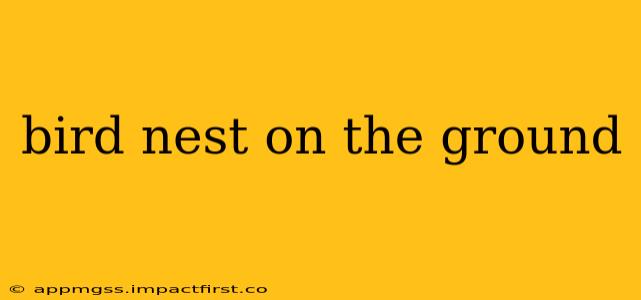Finding a bird's nest on the ground is a common occurrence, but it often raises concerns. Is it abandoned? Is the bird in danger? This comprehensive guide will explore the reasons why birds might build nests on the ground, what to do if you find one, and how to help ensure the safety of the birds.
Why Are There Bird Nests on the Ground?
Many bird species, contrary to popular belief, naturally build their nests on the ground. This isn't a sign of distress or abandonment in most cases. Ground nesting is a survival strategy employed by various species for several reasons:
-
Protection from Predators: While it might seem counterintuitive, ground nests can offer protection from aerial predators like hawks. The low profile makes them harder to spot. Some species rely on camouflage and swift escape to avoid danger.
-
Availability of Nesting Materials: Certain birds find readily available nesting materials like grass, twigs, and leaves closer to the ground, making ground nesting a practical choice.
-
Species-Specific Behavior: Many ground-nesting species have evolved specific behaviors and adaptations to thrive in this environment. These include precocial chicks (those that are mobile and relatively self-sufficient from birth), which can quickly flee from danger.
-
Lack of Suitable Tree Cavities or Branches: In areas with limited tree cover or suitable nesting sites in trees, ground nesting becomes a necessity.
Is the Bird Nest Abandoned?
Determining if a bird nest on the ground is abandoned requires careful observation. Don't rush to conclusions. Here are some signs that a nest might be abandoned:
- Obvious signs of decay: If the nest is significantly damaged, moldy, or smells foul, it may be abandoned.
- No parental activity: If you observe the nest for several hours and see no adult birds tending to the eggs or young, it might be abandoned. However, adult birds often forage for long periods, so brief absences aren't definitive.
- Dead eggs or chicks: Dead eggs or chicks are a clear indicator of abandonment, likely due to predation or disease.
Important Note: Disturbing the nest can be detrimental. The presence of humans can stress the parents and make them less likely to return. Keep a safe distance and observe from afar.
What Should I Do If I Find a Bird Nest on the Ground?
If you discover a bird's nest on the ground, your actions should prioritize minimal disturbance:
- Observe from a distance: Use binoculars if possible to monitor the nest without approaching too closely.
- Do not touch the nest or eggs: Human scent can deter the parents from returning.
- Keep pets away: Dogs and cats are significant predators of ground-nesting birds and their young.
- Protect the nest from harm: If the nest is in a vulnerable location, consider gently relocating it to a slightly more protected spot nearby, using the same materials and maintaining its original structure. This is a last resort and should only be done if absolutely necessary and with extreme caution.
- Educate others: If you're in a public area, inform others about the nest and the importance of keeping a safe distance.
What are some common ground-nesting birds?
Many species are ground nesters. The exact species will vary depending on your geographical location. Examples include:
- Killdeer: Known for their distinctive calls and their nests, which are often simple scrapes in the ground.
- Meadowlarks: These birds build nests in grassy fields and meadows.
- American Bittern: This secretive bird creates nests amongst vegetation near water.
- Bobolinks: They create nests in tall grasses and meadows.
How can I help protect ground-nesting birds?
Protecting ground-nesting birds requires community effort:
- Avoid disturbing nesting habitats: Be mindful of where you walk, especially in grassy areas.
- Keep pets on leashes: This will prevent them from disturbing nests or preying on birds.
- Support conservation efforts: Participate in habitat restoration projects or donate to organizations dedicated to bird conservation.
Finding a bird nest on the ground can be cause for concern, but by understanding the reasons behind ground nesting and taking appropriate actions, you can play a crucial role in protecting these vulnerable creatures. Remember, observation and minimal interference are key to ensuring the survival of these fascinating birds and their offspring.
